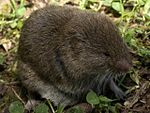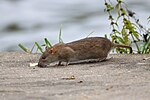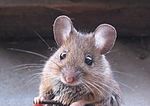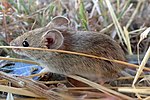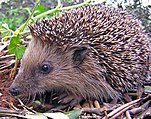List of mammals of Cantabria
The conservation status of wild mammals in Cantabria is also diverse, with sixteen species near-threatened, fifteen vulnerable and one, the brown bear, in critical danger of extinction.
Lagomorphs (Lagomorpha, from the Greek lagōs, hare and morphē, form) are an order belonging to the placental mammals related to rodents, from which they differ by possessing two pairs of upper teeth covered with a layer of enamel.
Three of them are endemic to the Iberian Peninsula and some, such as the broom hare, only inhabit the mountainous areas of the northern peninsular, between Galicia, Asturias, León and Cantabria.
It has long limbs and ears, the latter with black tips and yellowish-brown fur, except for the whitish belly area and little extension.
Thick, woolly coat, pale brown to gray, oval head and large eyes.
It differs from hares because its ears, somewhat shorter, do not end in black tips and has a less elongated and slender body.
[9] Although they have developed a great variety of forms as a result of adaptation to different habitats and ecological niches, the species present in Cantabria have in common their relatively small size, thick grayish-brown fur and short legs and neck.
The coypu, an invasive species native to South America and cited in the Soba valley, is the one that most deviates from the common pattern, slightly exceeding half a meter in length and six kilograms in weight.
Brown dorsal coat with grayish belly with small eyes and ears, its snout is rounded and its tail is slightly longer than half of the body.
NV: Ratu (name for all mice, in general) Small-sized murid, with rounded snout, small eyes and ears.
They have a chestnut gray dorsal coloration, with a darker stripe from the head to the beginning of the tail, grayish white belly, clearly separated from the dorsum.
It is easily differentiated from Mus musculus by its coloration and by the relative length of the tail, which is much shorter than the body.
A large rodent with a shiny brown coat, denser on the back, introduced in the northern peninsula from specimens that escaped from fur farms in France.
[10] It has several adaptations to semi-aquatic life: webbed hindlimbs; small ears; eyes and nostrils located on the dorsal part of the head.
[30] With a stocky body covered with spikes on the back and flanks, the hedgehog has a mobile, pointed snout, small, rounded eyes and ears, and a brown face, belly and limbs.
The soricomorphs (Soricomorpha) are a suborder of placental mammals containing the families Nesophontidae, Solenodontidae, Soricidae, and Talpidae.
[41][42] Large bat with long and narrow wings, head typical of the genus, rigid ears projected forward.
NV: Common to all the family (Spanish) murcielago, murciágano/u, murciégano, sapulatu/o, spulatu,[44]sapalatu, saparnatu,[45] sapu jelau.
NV: Common to all the family (Spanish) murcielago, murciágano/u, murciégano, sapulatu/o, spulatu,[44]sapalatu, saparnatu,[45] sapu jelau.
White stripe of 2 mm, visible and well delimited on the posterior edge of the wing membrane, between the fifth toe and the foot.
Muzzle short with glandular bulges on both sides next to the labial glands (mouthparts), whitish in color.
[64] Small canid with reddish tones and solitary habits, it has a long and bushy tail with a white tip.
Gray brindle in color, it has 3 to 5 dark rings on its short tail, which ends in a rounded black tip.
The polecat's body is elongated and flexible, with short legs, small, broad and flattened head and rounded, barely protruding ears.
Its fur varies between gray, brown and yellowish on the back, being black on legs and belly; while the face is white with a dark mask.
NV: Martuju[76] Mustelid with small head, sharp muzzle, slender body and short legs.
It differs from the beech marten (M. foina) in having larger ears, a sharper muzzle and a cream-colored throat instead of white.
[85] Introduced by the Arabs to hunt mice, the genet has a slender, mottled body, striped tail, black muzzle and pointed ears.
parva) is characterized by its small hooked horns and the two dark stripes that cover the eyes like a mask.
[92] An ancestor of the domestic pig, it has a large, elongated head, thick neck and short legs.









